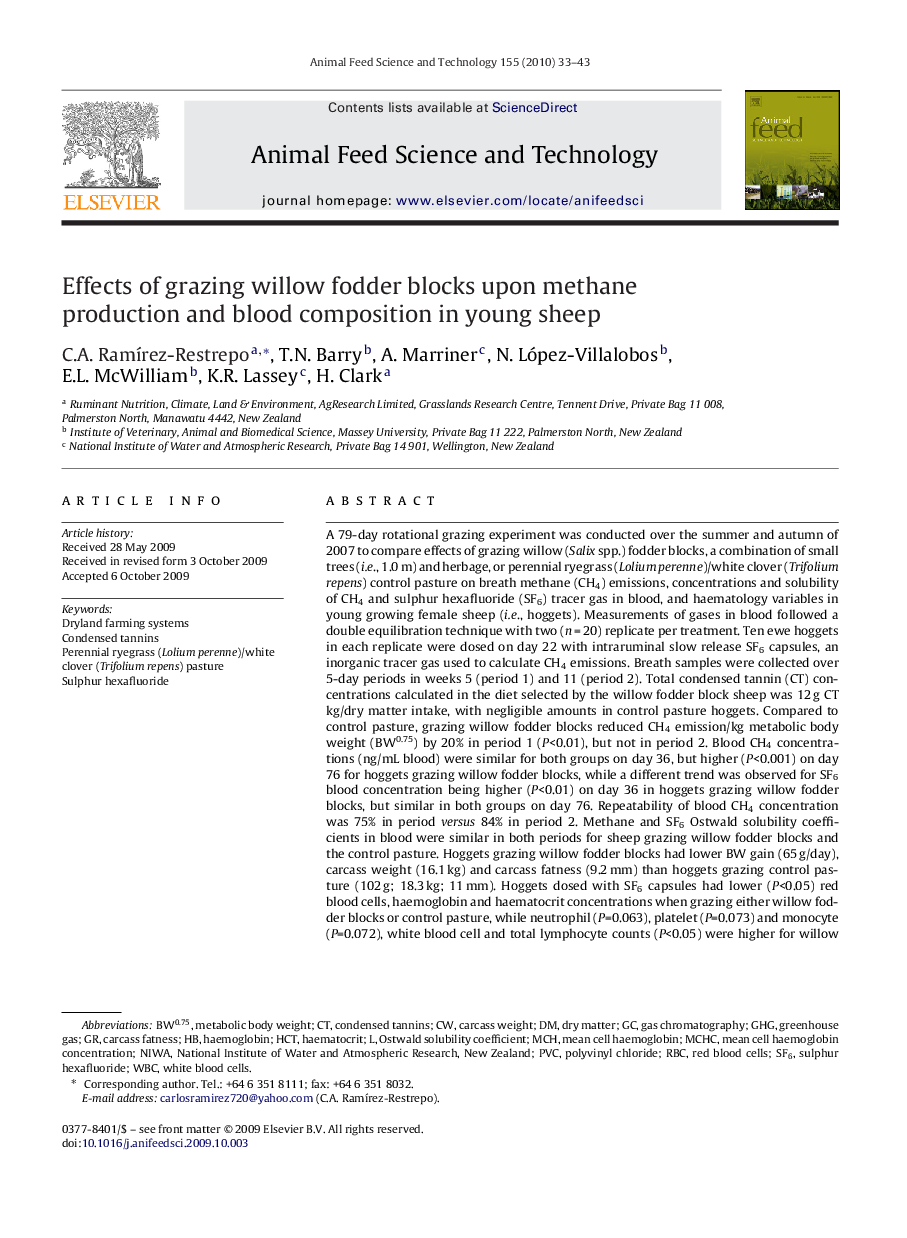| کد مقاله | کد نشریه | سال انتشار | مقاله انگلیسی | نسخه تمام متن |
|---|---|---|---|---|
| 2420441 | 1104809 | 2010 | 11 صفحه PDF | دانلود رایگان |

A 79-day rotational grazing experiment was conducted over the summer and autumn of 2007 to compare effects of grazing willow (Salix spp.) fodder blocks, a combination of small trees (i.e., 1.0 m) and herbage, or perennial ryegrass (Lolium perenne)/white clover (Trifolium repens) control pasture on breath methane (CH4) emissions, concentrations and solubility of CH4 and sulphur hexafluoride (SF6) tracer gas in blood, and haematology variables in young growing female sheep (i.e., hoggets). Measurements of gases in blood followed a double equilibration technique with two (n = 20) replicate per treatment. Ten ewe hoggets in each replicate were dosed on day 22 with intraruminal slow release SF6 capsules, an inorganic tracer gas used to calculate CH4 emissions. Breath samples were collected over 5-day periods in weeks 5 (period 1) and 11 (period 2). Total condensed tannin (CT) concentrations calculated in the diet selected by the willow fodder block sheep was 12 g CT kg/dry matter intake, with negligible amounts in control pasture hoggets. Compared to control pasture, grazing willow fodder blocks reduced CH4 emission/kg metabolic body weight (BW0.75) by 20% in period 1 (P<0.01), but not in period 2. Blood CH4 concentrations (ng/mL blood) were similar for both groups on day 36, but higher (P<0.001) on day 76 for hoggets grazing willow fodder blocks, while a different trend was observed for SF6 blood concentration being higher (P<0.01) on day 36 in hoggets grazing willow fodder blocks, but similar in both groups on day 76. Repeatability of blood CH4 concentration was 75% in period versus 84% in period 2. Methane and SF6 Ostwald solubility coefficients in blood were similar in both periods for sheep grazing willow fodder blocks and the control pasture. Hoggets grazing willow fodder blocks had lower BW gain (65 g/day), carcass weight (16.1 kg) and carcass fatness (9.2 mm) than hoggets grazing control pasture (102 g; 18.3 kg; 11 mm). Hoggets dosed with SF6 capsules had lower (P<0.05) red blood cells, haemoglobin and haematocrit concentrations when grazing either willow fodder blocks or control pasture, while neutrophil (P=0.063), platelet (P=0.073) and monocyte (P=0.072), white blood cell and total lymphocyte counts (P<0.05) were higher for willow fodder block-fed hoggets than those fed the control pasture. Differences in the reduction in CH4 emission between periods from grazing willow fodder blocks may be due to more willow leaf being eaten during the CH4 measurement period in period 1 than in period 2.
Journal: Animal Feed Science and Technology - Volume 155, Issue 1, 20 January 2010, Pages 33–43